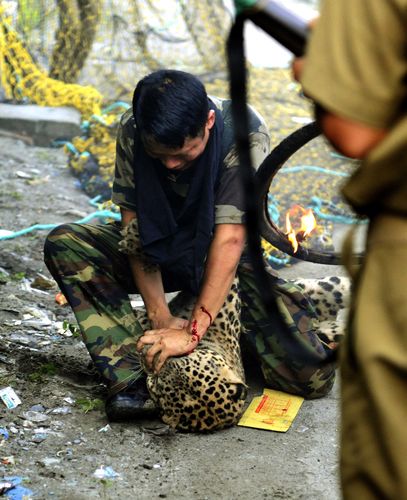On July 18, 2011, the West Bengal government and the Gorkha Janmukti Morcha signed the historic Gorkhaland Territorial Administration agreement at Pintail village in Salugara, ending decades-old agitation for a separate state. On a high after signing the deal, Chief Minister Mamata Banerjee left for the Mahananda Wildlife Sanctuary. As the GJM was planning to read out the agreement to the Nepali community in their language, I stayed back looking for some celebratory pictures.
At a tea stall, I heard local people say that a leopard had strayed from the jungle near Limbu, a village 10 kilometres away. I was familiar with it, having worked in the region for The Statesman. I asked a journalist-friend to find out details. After calling forest department officials, he confirmed the news. I borrowed his bike and rushed to the spot.
When I reached, I saw people thronging an abandoned construction site. I shoved my way through the crowd and came close to a dense bush where the leopard was hiding. Nervous and thrilled, I asked a forest department official about how the animal would behave in such a situation. One of his answers stuck: “A leopard always attacks the side from where he has been attacked.”
I climbed a brick wall, jumped on to a tin roof and assumed position with my camera. From my place, I was able to see everything clearly. Three forest guards had arrived with tranquilliser guns, wearing helmets. A forest department driver went close to the bush and started throwing stones. As soon as he had thrown the second stone, the leopard attacked him. The animal, however, soon gave up and withdrew into its hideout.
When the police arrived, the efforts to track down the animal’s movements had reached heights of cruelty: firecrackers and burning tyres were thrown in the direction of the bush. Nothing happened. But just when everyone concluded that the leopard had died, it let out a roar and attacked the forest guards stationed on a rescue van.
A police constable posted near the van thrust his hand inside the leopard’s mouth to stop its advances. I watched with disbelief as the forest guards stabbed it with kukris, a curved Nepalese knife. The leopard, which soon went limp, was netted and taken to Sukna Rescue Centre, where it was declared dead.

Honours
© Prize in news photography category, WAN-IFRA Asian Media Awards 2012, Bali
© Award in spot news singles category, World Press Photo foundation, Amsterdam
© Best Photojournalist (spot news), On Asia Photo Awards, Foreign Correspondents Club of Thailand, Bangkok
© 2011 National Photo Award for best professional photographer, Photo Division, Govt of India
© Best News Photography prize, Candid Communications West Bengal Journalism Awards
© Shortlisted for the Sony World Photography Award (professional category), London
© Nominated for the Prix Pictet Photography Prize, London
Publications which carried the photo
© The Sunday Times, London
© Photo, France
© Focus, Italy
© Discover Magazine, USA






